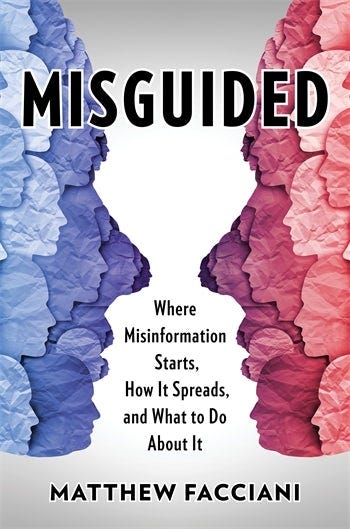Misguided: Where Misinformation Starts, How It Spreads, and What to Do About It
My book launches today and explores the social psychology behind why we believe falsehoods.
I’m so thrilled to share that my book Misguided officially launches today!
I started writing Misguided about five years ago during the height of the COVID-19 pandemic. My goal was to help us all better understand why smart, well-meaning people — including ourselves — can believe and share false information, and what we can do about it. In an age where misinformation seems to be everywhere, I wanted to provide a grounded, research-based, and empathetic guide for navigating our chaotic information environment. Over the years, I’ve incorporated a wealth of cutting-edge research from misinformation scholars, along with insights from my own work in the field.
Here’s what you’ll find in the book, and why I think it matters.
Why Do People Believe Things That Aren’t True?
We all have that friend or family member who shares a dubious claim on social media, and we might wonder: How could they possibly believe that?
What I’ve found, and what I lay out in Misguided, is that believing falsehoods is not simply about ignorance or irrationality. Often, it’s about social and psychological forces: our need to belong, our desire to affirm our identities, and the ways our social networks reinforce our beliefs.
From conspiracies like flat-earth to health myths like vaccine misinformation, false beliefs can feel rational and even rewarding because they connect us to a community, reinforce who we think we are, and shield us from uncomfortable truths.
Key Insights From Misguided
Here are a few of the main ideas you’ll take away from the book:
Misinformation is nothing new — but it spreads faster now. From a fake country called Poyais in the 1800s to modern-day fake news, the mechanisms are similar: emotional appeal, trust & mistrust, and social reinforcement.
Identities shape what we believe. Identities provide us with a source of self-esteem, and we are motivated to protect them. Our political, cultural, and personal identities make us more receptive to certain narratives, even if they aren’t true.
Social networks matter. Friends, family, online communities, and algorithms amplify misinformation by making it feel more credible and more popular than it really is; their support can reinforce our social identities.
Misinformation has real consequences. It has fueled violence, undermined public health, eroded trust in institutions, and polarized societies.
We’re all vulnerable. Biases like confirmation bias and motivated reasoning affect everyone. It’s not just “them.” My book dives into where such confirmation biases stem from in the first place.
We can build resilience. Through techniques like media literacy, prebunking, fostering trust, and learning how to have productive conversations, we can reduce the impact of false information.
What You’ll Learn
The book walks you through:
How misinformation spreads and why it sticks.
Why identities and social ties can override facts.
How the COVID-19 pandemic became a case study in misinformation.
How the anti-vaccine movement shows the dangers of eroded trust.
What science, education, and good conversation can do to help.
What challenges lie ahead with new technologies like AI.
Why I Wrote This Book
From my time as a researcher, educator, and science communicator, I’ve seen how misinformation shapes policies, harms health, and tears at the fabric of communities. And I’ve seen how evidence, empathy, and understanding can make a difference, if we know where to start.
I hope Misguided helps readers approach the problem not just as an “us vs. them” battle, but as a shared challenge we all face, and can all work to solve.
You can now find Misguided: Where Misinformation Starts, How It Spreads, and What to Do About It at major booksellers. Amazon is currently offering a 50% off sale for the digital version, Columbia University Press is offering a 20% sale on the paperback with the code CUP20, and Bookshop.org currently has free shipping.
If you enjoy the book, you can help me out a ton by leaving a review on Amazon/Goodreads, or by sharing my book with a friend or on social media.
Thank you to everyone who has supported this journey, and I hope you’ll join me in learning how to see through the noise and build resilience in the face of misinformation.




